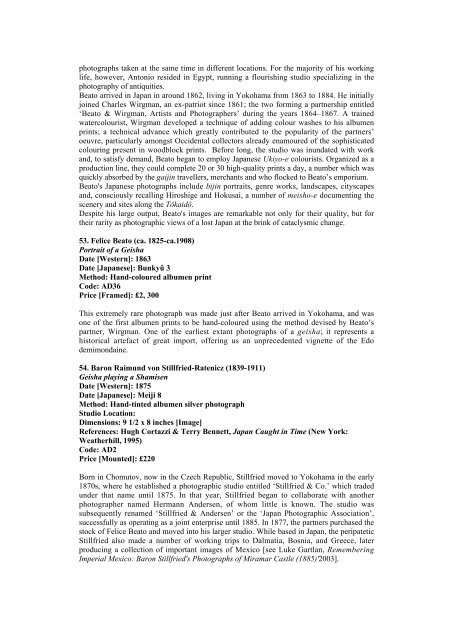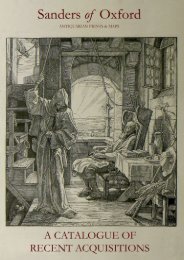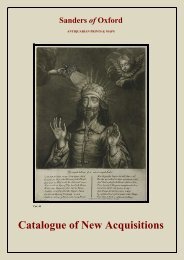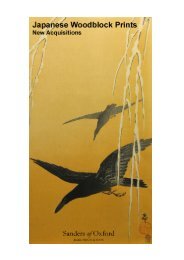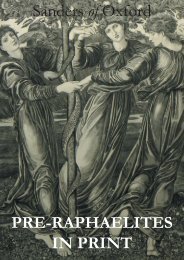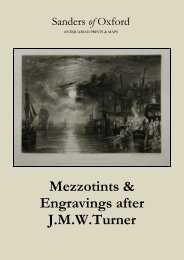You also want an ePaper? Increase the reach of your titles
YUMPU automatically turns print PDFs into web optimized ePapers that Google loves.
photographs taken at the same time in different locations. For the majority <strong>of</strong> his working<br />
life, however, Antonio resided in Egypt, running a flourishing studio specializing in the<br />
photography <strong>of</strong> antiquities.<br />
Beato arrived in Japan in around 1862, living in Yokohama from 1863 to 1884. He initially<br />
joined Charles Wirgman, an ex-patriot since 1861; the two forming a partnership entitled<br />
‘Beato & Wirgman, Artists and Photographers’ during the years 1864–1867. A trained<br />
watercolourist, Wirgman developed a technique <strong>of</strong> adding colour washes to his albumen<br />
prints; a technical advance which greatly contributed to the popularity <strong>of</strong> the partners’<br />
oeuvre, particularly amongst Occidental collectors already enamoured <strong>of</strong> the sophisticated<br />
colouring present in woodblock prints. Before long, the studio was inundated with work<br />
and, to satisfy demand, Beato began to employ Japanese Ukiyo-e colourists. Organized as a<br />
production line, they could complete 20 or 30 high-quality prints a day, a number which was<br />
quickly absorbed by the gaijin travellers, merchants and who flocked to Beato’s emporium.<br />
Beato's Japanese photographs include bijin portraits, genre works, landscapes, cityscapes<br />
and, consciously recalling Hiroshige and Hokusai, a number <strong>of</strong> meisho-e documenting the<br />
scenery and sites along the Tôkaidô.<br />
Despite his large output, Beato's images are remarkable not only for their quality, but for<br />
their rarity as photographic views <strong>of</strong> a lost Japan at the brink <strong>of</strong> cataclysmic change.<br />
53. Felice Beato (ca. 1825-ca.1908)<br />
Portrait <strong>of</strong> a Geisha<br />
Date [Western]: 1863<br />
Date [Japanese]: Bunkyû 3<br />
Method: Hand-coloured albumen print<br />
Code: AD36<br />
Price [Framed]: £2, 300<br />
This extremely rare photograph was made just after Beato arrived in Yokohama, and was<br />
one <strong>of</strong> the first albumen prints to be hand-coloured using the method devised by Beato’s<br />
partner, Wirgman. One <strong>of</strong> the earliest extant photographs <strong>of</strong> a geisha; it represents a<br />
historical artefact <strong>of</strong> great import, <strong>of</strong>fering us an unprecedented vignette <strong>of</strong> the Edo<br />
demimondaine.<br />
54. Baron Raimund von Stillfried-Ratenicz (1839-1911)<br />
Geisha playing a Shamisen<br />
Date [Western]: 1875<br />
Date [Japanese]: Meiji 8<br />
Method: Hand-tinted albumen silver photograph<br />
Studio Location:<br />
Dimensions: 9 1/2 x 8 inches [Image]<br />
References: Hugh Cortazzi & Terry Bennett, Japan Caught in Time (New York:<br />
Weatherhill, 1995)<br />
Code: AD2<br />
Price [Mounted]: £220<br />
Born in Chomutov, now in the Czech Republic, Stillfried moved to Yokohama in the early<br />
1870s, where he established a photographic studio entitled ‘Stillfried & Co.’ which traded<br />
under that name until 1875. In that year, Stillfried began to collaborate with another<br />
photographer named Hermann Andersen, <strong>of</strong> whom little is known. The studio was<br />
subsequently renamed ‘Stillfried & Andersen’ or the ‘Japan Photographic Association’,<br />
successfully as operating as a joint enterprise until 1885. In 1877, the partners purchased the<br />
stock <strong>of</strong> Felice Beato and moved into his larger studio. While based in Japan, the peripatetic<br />
Stillfried also made a number <strong>of</strong> working trips to Dalmatia, Bosnia, and Greece, later<br />
producing a collection <strong>of</strong> important images <strong>of</strong> Mexico [see Luke Gartlan, Remembering<br />
Imperial Mexico: Baron Stillfried's Photographs <strong>of</strong> Miramar Castle (1885)'2003].


